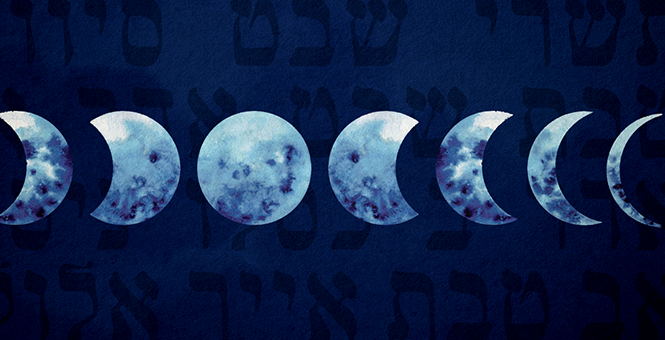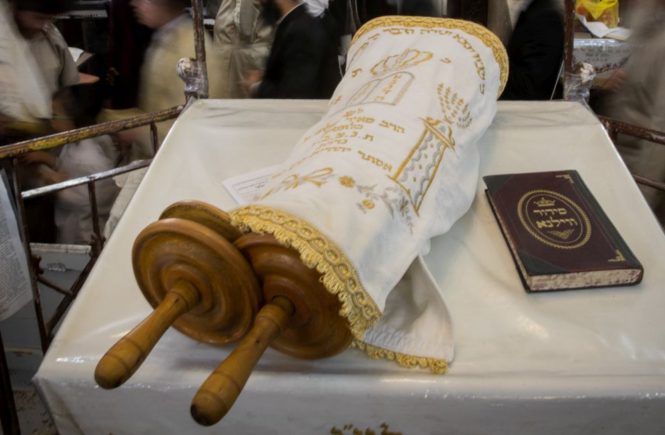1. The Hebrew Calendar Is Based on the Moon
At the cusp of the Exodus, G‑d commanded Moses regarding the Hebrew calendar. Each time witnesses spotted the sliver of a burgeoning moon in the night sky, the start of the new month was declared. The month Nisan, which coincides with the budding of spring—the season of the Exodus—would be the first month of the new year.
In ancient times, witnesses who saw the new moon would hurry to the central court (the Sanhedrin) to report their findings. In the 4th century CE, the sage Hillel II foresaw the disbandment of the Sanhedrin, and understood that soon we would no longer be able to follow a Sanhedrin-based calendar. He and his rabbinical court established the perpetual calendar which we follow today. When Hillel established the perpetual calendar, he sanctified every new month until Moshiach will come and re-establish the Sanhedrin.
2. The Moon Was Made Smaller by G‑d
The Talmud tells us that the sun and the moon were originally equal in size and luminosity. The moon said to the Holy One, blessed be He, “Master of the Universe! Is it possible for two kings to wear one crown?”
He answered: “Go, then, and diminish yourself.”
“Master of the Universe!” cried the moon, “because I have suggested that which is proper must I then make myself smaller?”
G‑d replied: “As compensation, go and rule by day and by night.”
“But what is the value of this?” cried the moon. “Of what use is a candle in broad daylight?”
He replied: “Go. Israel shall count the days and the years with you.”
“But it is impossible,” said the moon, “to do without the sun for the counting of the season…”
“Go. The righteous shall be named after you, as we find, Jacob the Small,Samuel the Small, David the Small.”
Seeing that the moon could not be comforted, G‑d said: “Bring an atonement for Me for making the moon smaller.”
3. The Jews Wax and Wane, Just Like the Moon
It’s no accident that the Jewish calendar is based on the moon. For the first 15 days of the month, the moon grows from a sliver to a shining disc. In the same way, throughout the 15 generations from Abraham to Solomon, the Jewish people grew from a single brilliant iconoclast to a powerful nation with a Holy Temple. From there, things progressively dimmed, until, 15 generations later, our light had disappeared with the defeat of King Zedekiah. But like the moon, our story does not end in darkness, for when the moon is completely hidden, we know that its light will once again burst forth.
4. Sun and Moon: Esau and Jacob
Noting that Rome (descendants of Esau) uses a solar calendar in which the months are completely divorced from the lunar cycle, the rabbis of the Midrash say that it is entirely natural that the bigger (older) brother, Esau, take the larger of the heavenly orbs for its sign, while the younger brother, Jacob (progenitor of the Jewish People), takes the smaller of the two, the moon, as his guide.
But there is a hidden message: The sun is bigger but it sets completely at night. The moon, on the other hand, can be seen during the day and during the night. Esau sees success in This World (which is compared to day) but has nothing in the World to Come (likened to the nighttime). Jacob, by contrast, has a portion in This World, as well as in the World to Come.
5. Being Grateful for the Moon Is Akin to Greeting G‑d
Every month, Jewish people recite a special blessing—known as Kiddush Levanah—as they witness the moon re-emerge and grow full again. Blessing the month in its time is comparable to greeting the Divine presence, said the Sages of the Talmud.
6. Moses and Joshua Are Like Sun and Moon
The Talmud compares Moses and Joshua to the sun and moon, respectively.7
Moses was like the sun, the source of light, because he delivered the Torah and brought the light of G‑dliness into the world. He represents a top-to-bottom approach to serving G‑d.
Joshua, on the other hand, is compared to the moon, which has no light of its own and merely reflects the sun’s light. This represents a bottom-up approach to G‑dly service; the idea of transforming and elevating the physical world into a “moon,” a vessel for G‑dly light.
7. The Poor Are Compared to the Moon
The Zohar compares the poverty-stricken to the moon, who has no light of her own. Nevertheless, they say, just as the sun gives freely of her light to the moon and loses nothing in the process, so must we give of our wealth to those who have less. “Borrow on my account,” G‑d promises, “and I will pay you back.”
8. Lunar Eclipses Are Bad Omens
The Talmud tells us that a lunar eclipse is considered a bad sign for the Jews, who calculate the months according to the lunar cycle. This must be considered, however, alongside the parallel teaching that “when Jews perform the will of G‑d, they need not worry about omens or celestial phenomena. For thus says the L‑rd, ‘Do not be frightened by the signs of the heavens.’
9. Moonlight Is for Torah Study
The Talmud records the study habits of several rabbis. Some preferred to get a good night’s sleep to learn with gusto during the day, while others saw merit in utilizing the quiet nighttime hours for Torah study. Resh Lakish (a night owl) was wont to say: The moon was only created for study[ing by its light].
10. It’s the ‘White Collector’
There are two Hebrew words for “moon:” yare’ach, which is related to the Hebrew word for “month,” and “levanah,” which means “white.” In the mystical works, the levanah, a blank slate that receives its brilliance from elsewhere, is associated with Malchut (“royalty”), which has nothing of its own, but collects and redirects the radiance of the Divine facets that precede it.
Whiteness, the absence of color, implies something that has been washed and purified. In that sense, the Zohar explains, the moon is associated with the halachah, the product of extensive probing and distilling of traditions, before the final decision crystallizes.




